Hitesh Mehta is the director of HM Design, and one of the world’s leading authorities, practitioners and researchers on ecotourism physical planning, landscape architecture and architectural aspects of ecolodges.
In her Q&A series, guest blogger Meg Pier uncovers the principles behind eco-architecture and landscaping and how the experts overcome roadblocks in developing sustainable tourism.
Mehta, 50, refers to himself as a citizen of the world and has traveled to more than 75 countries and consulted in 50, including Egypt, Rwanda, Fiji, the U.S. and Puerto Rico.
In 2006, National Geographic Adventure magazine identified Hitesh as one of five Sustainable Tourism Pioneers in the world. His coffee-table book, Authentic Ecolodges, will be published by Harper Collins in September.
Meg Pier: Tell me a little bit about growing up in Kenya.
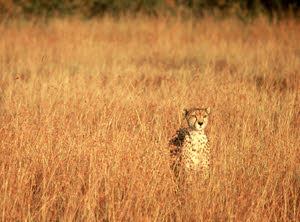 Hitesh Mehta: I feel blessed to have grown up in Kenya which has been for many years a peaceful haven in Africa. Raised in Nairobi by Indian parents, I can enthusiastically describe my childhood as modest, moral, and set against a truly magical backdrop. I grew up in Parklands, an Indian suburb designated by the British Colonialists, which was bordered by the forested City Park. I experienced nature just outside my door: there used to be leopard sightings in my neighborhood, while vervet and sykes monkeys were a daily occurrence!
Hitesh Mehta: I feel blessed to have grown up in Kenya which has been for many years a peaceful haven in Africa. Raised in Nairobi by Indian parents, I can enthusiastically describe my childhood as modest, moral, and set against a truly magical backdrop. I grew up in Parklands, an Indian suburb designated by the British Colonialists, which was bordered by the forested City Park. I experienced nature just outside my door: there used to be leopard sightings in my neighborhood, while vervet and sykes monkeys were a daily occurrence!
MP: How do you define landscape architecture?
HM: Landscape architecture is the design of outdoor and public spaces to achieve environmental, socio-behavioral, and/or aesthetic outcomes. The basic premise of landscape architecture is about stewardship of the land. How to take care of the land while at the same time design it in ways that provide places of rest, meditation and recreation for all species.
Check out Meg Pier’s previous interview: Global Heritage Fund Co-Founder Talks Sustainable Tourism.
MP: Was where you grew up a factor?
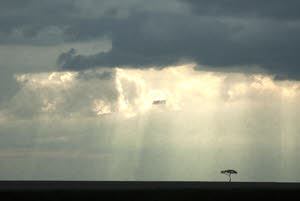 HM: Kenya has one of the natural wonders of the world: the Great Rift Valley, snow-capped mountains on the equator, fresh and salt-water lakes, rivers, equatorial and mountain forests, deserts, savannah, oceans, and, of course, one of the highest concentrations of mammals on the planet. In addition, Nairobi is the only city in the world that has a National Park within its boundaries.
HM: Kenya has one of the natural wonders of the world: the Great Rift Valley, snow-capped mountains on the equator, fresh and salt-water lakes, rivers, equatorial and mountain forests, deserts, savannah, oceans, and, of course, one of the highest concentrations of mammals on the planet. In addition, Nairobi is the only city in the world that has a National Park within its boundaries.
The pristine yet fragile landscape around me and my wish to protect it for future generations was an influencing factor of why I chose to pursue a profession of landscape architecture.
MP: Landscape architecture related to ecotourism is a specialty of yours. Can you describe how that expertise came about and evolved?
Explore the Eco-Lodges of Belize.
HM: Fifteen years ago, I felt strongly that I needed to take all my interests—architecture, landscape architecture and conservation—and combine them into one. I noticed the striking disconnect between architecture and the landscape on which the safari lodges were built: ugly, modern buildings that were anything but timeless.
 I remember asking myself, “As landscape architects and planners, are we truly the stewards of the land and oceans, or are we destroyers?” I developed a precocious interest in relationships between landscape architecture, environmentalism, local community benefits, and tourism.
I remember asking myself, “As landscape architects and planners, are we truly the stewards of the land and oceans, or are we destroyers?” I developed a precocious interest in relationships between landscape architecture, environmentalism, local community benefits, and tourism.
In 1995, I wrote what is considered the first research paper on ecolodges in the world. I decided that my calling was to go deeper than simply helping to control the aesthetic features of my residential house projects. As such, my focus in landscape architecture moved to pristine and fragile natural areas where tourism was uncontrolled, and had large social and environmental impacts and required a new planning paradigm to protect the sanctity of those places. Projects in national parks, for example, would need careful storm water and wastewater discharge, non-invasive plant species, alternative energy sources and energy conversation methods.
Learn more: Eco-Travel: Rainforest Foraging in Costa Rica.
MP: Can you share two or three of the principles of landscape architecture that most resonate with you, and how they might be applied to everyday life?
HM: Stewardship, taking care of Mother Earth and all the species that inhabit on it. The concept of being light on the land and respecting other species. Trying to create the least amount of destruction on the land.
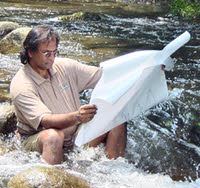 Second is the inclusion of local communities. It is important in daily life to be cognizant of minority communities and respect all people irrespective of caste, creed or race.
Second is the inclusion of local communities. It is important in daily life to be cognizant of minority communities and respect all people irrespective of caste, creed or race.
Also important is harmony. Being in harmony with nature is an important element of human’s survival on the planet.
MP: Do you consider your work to be a spiritual practice?
HM: Every one of my projects in the last 10 years has espoused what I have termed as the “quadruple bottom line” approach to sustainability: financial, social and environmental have been the accepted aspects for creating sustainable places. But without the fourth aspect, spiritual, one cannot attain sustainability.
I design places that cater to travelers who want to learn about other places and people rather than just escape their familiar surroundings but at the same time make a positive difference to the locations they visit. Ecolodges are designed to protect the natural environment and support their communities and I see this approach as spiritual.
Find more green vacations in our Eco-Travel section.
MP: Could you describe the challenges and opportunities presented by a project’s particular landscape?
HM: I was the facilitator and team leader for the preparation of a desert ecolodge in the Al Ghat National Park, three hours north of Riyadh in Central Saudi Arabia.
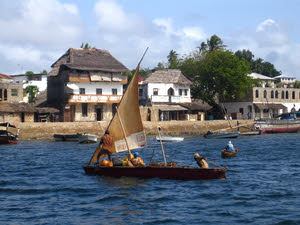 There was so little rainfall in the desert that it truly was a challenge to figure out how we were going to ensure regular water supply for ecolodge guests. Another challenge was the dust wind storms that occur several times of the year in the desert. We had to orient and protect the buildings such that they would not be affected by the dust. Being a true desert, there were very few plants that had adapted to the harsh conditions.
There was so little rainfall in the desert that it truly was a challenge to figure out how we were going to ensure regular water supply for ecolodge guests. Another challenge was the dust wind storms that occur several times of the year in the desert. We had to orient and protect the buildings such that they would not be affected by the dust. Being a true desert, there were very few plants that had adapted to the harsh conditions.
Another memorable project was leading the development of a tourism plan for the protected area of Virunga Massif along the borders of the Democratic Republic of Congo, Rwanda and Uganda. The area harbors half of the world’s mountain gorilla population and eight volcanoes. One of the main purposes of this long-term plan was to demonstrate how tourism can help alleviate livelihoods of local people. The overall plan includes hotels and camping sites, ecolodges, visitor centers, boardwalks, canopy walks, trails, entry gates, park administrative offices, visitor / interpretive center, local crafts markets and tourism information offices.
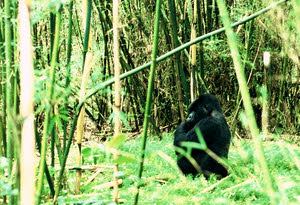 I wanted to walk the base of the volcanoes of DR Congo but was informed that it had far more human guerrillas—Hutus from Rwanda—than gorillas! It was so dangerous to travel around Eastern Congo that, at any given time, I had five Army guards with AK 47’s protecting me as I carried on with my work! That said, Congo landscapes are some of the most magical on the planet.
I wanted to walk the base of the volcanoes of DR Congo but was informed that it had far more human guerrillas—Hutus from Rwanda—than gorillas! It was so dangerous to travel around Eastern Congo that, at any given time, I had five Army guards with AK 47’s protecting me as I carried on with my work! That said, Congo landscapes are some of the most magical on the planet.
Because of projects such as these, I introduced in 2004, a new profession in the industry called “Extreme Planning.” It is a profession that cannot be taught in universities and can only be learned on the field. It’s a calculated-risk-taking profession where the planner is so passionate about making a difference in the world that he/she is willing to die for a cause.
It is planning in areas of civil unrest, deadly diseases, war, political instability; in severe weather conditions such as monsoons, sub-freezing and desert; planning that helps conserve the last remaining endangered floral and fauna; that helps protect indigenous cultures, languages and sacred landscapes and that helps raise living standards for impoverished local peoples.
Check out another in-depth report on eco-travel in Costa Rica with Volunteer Vacations: Paying to Travel, Work and Save the Sea Turtles.
MP: We’ve been engaged in this dialogue while you are in China—could you share what you are up to there?
 HM: I am currently in Zhuhai, a 7 million population city in the Pearl River Delta of Southern China and 1.5 hours ferry from Hong Kong. I am leading a team of three consultants and we are here to plan a unique, socially and environmentally friendly new urban village, Qianshan New Village, for a Chinese client. I have not worked on urban projects of this scale but the challenge to create something never created in China is exciting!
HM: I am currently in Zhuhai, a 7 million population city in the Pearl River Delta of Southern China and 1.5 hours ferry from Hong Kong. I am leading a team of three consultants and we are here to plan a unique, socially and environmentally friendly new urban village, Qianshan New Village, for a Chinese client. I have not worked on urban projects of this scale but the challenge to create something never created in China is exciting!
China is a very hot topic in the design world and much of the press coverage is about the environmental and social degradation going on with the rapid development. In a country where uncontrolled development is causing untold damage and displacing millions of people, Qianshan New Village will be an exemplary study in environmental and social consciousness.
Learn more in our China Travel section.
MP: What are a couple of the most interesting new trends in ecotoursim in your view?
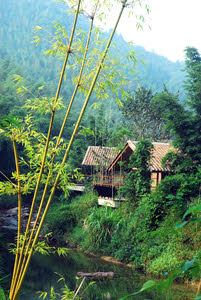 HM: Community-owned and operated ecolodges. This concept started in Kenya but now has spread all over the world. These are projects which are entirely owned and operated by the local communities, such as Maasai Mara and Native Americans in the Bolivian Amazon.
HM: Community-owned and operated ecolodges. This concept started in Kenya but now has spread all over the world. These are projects which are entirely owned and operated by the local communities, such as Maasai Mara and Native Americans in the Bolivian Amazon.
A second interesting trend is that more and more ecotourism enterprises are adding “wellness centers” to their program of offerings.
Another is the expansion into higher quality lodges. The upgrading of facilities is a response to the growing upper middle-class “experience seekers” and “metro-spirituals’”market.
MP: It would seem to me that your work involves acknowledging the inter-dependencies of all the attributes of a given landscape.
HP: Everything in the landscape is inter-connected and dependent on each other. The flowers are dependent on the butterflies and bees, the fruit dependent on the flowers getting pollinated, the birds and monkeys dependent on the fruit, the eagles and leopards dependent on the monkeys. Every single species is connected in this web of life. It is indeed a metaphor for our lives. As humans, we are dependent on so many things—not only those that are man-made but those things that come from nature. If the natural web-link is destroyed by humans then our own existence will be in peril. In fact, it already is!
MP: What gives you hope for the planet, with all the current environmental challenges?
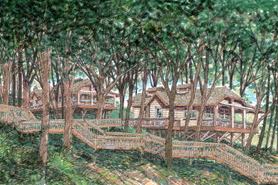 HM: There is no question that in my job, the everyday news can be quite depressing but my faith in the Universe keeps me going. It is the small stories that I hear makes me heartened: the fact that mountain gorilla populations are increasing; the fact that new protected areas are being created in Brazil and Borneo; the fact that more and more people are becoming aware of climate change and changing lifestyles. I have noticed in the past two years the increasing number of Americans who are turning to lower-impact lifestyles.
HM: There is no question that in my job, the everyday news can be quite depressing but my faith in the Universe keeps me going. It is the small stories that I hear makes me heartened: the fact that mountain gorilla populations are increasing; the fact that new protected areas are being created in Brazil and Borneo; the fact that more and more people are becoming aware of climate change and changing lifestyles. I have noticed in the past two years the increasing number of Americans who are turning to lower-impact lifestyles.
MP: Can you describe a specific experience of awe and/or wonder that was particularly powerful for you?
HM: The Maasai Mara Savannah in Kenya never ceases to amaze me! I am in awe of it every single time I visit this one-of-a kind landscape. It is one of those few magical places on the planet that has an irresistible spiritual energy. I have already chosen my resting place to be in the southern part of this landscape.
By Meg Pier. For the complete interview, visit www.viewfromthepier.com/. Photos courtesy of Hitesh Mehta.
Related links on PeterGreenberg.com:












